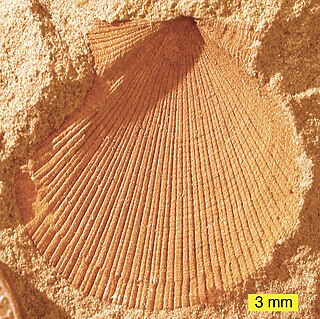 W
WActinoceramus is an extinct genus of fossil saltwater clams, marine pteriomorphian bivalve molluscs. These bivalves were facultatively mobile infaunal suspension feeders.
 W
WAviculopecten is an extinct genus of bivalve mollusc that lived from the Early Devonian to the Late Triassic in Asia, Australia, Europe, North America, and South America.
 W
WEocystites was a genus of Cambrian stem-group echinoderm of Australia and Vermont.
 W
WMyoscolex is an early animal species known from the Cambrian Emu Bay Shale in South Australia. Originally interpreted as an annelid, it seems to be an arthropod; the possible presence of an Opabinia-like proboscis, eyes, and flaps suggests a plausible relationship with that species. Myoscolex is the earliest known example of phosphotized muscle tissue, and as to which shows distinct annulation.
 W
WNectocaris pteryx is a species of possible cephalopod known from the "early Cambrian" Emu Bay Shale and Chengjiang biota, the "middle Cambrian" Burgess Shale.
 W
WNeithea is an extinct genus of bivalve mollusks that lived from the Early Jurassic to the early Paleocene, with a worldwide distribution. Neithia sp. are inequivalve. That means that the two valves are not the same shape, the right valve being strongly concave and the left valve being flattened or concave. Sculpture consist of alternating strong and weaker radiating ribs.
 W
WOrmoceras is an actinocerid nautiloid genus and type for the family Ormoceratidae, found in North America from the late Chazyan through the early Cincinnatian of the Middle and Upper Ordovician, but which continued through the Devonian worldwide.
 W
WTerebratula is a modern genus of brachiopods with a fossil record dating back to the Late Devonian. These brachiopods are stationary epifaunal suspension feeders and have a worldwide distribution.
 W
WVictorithyris is a genus of brachiopod from southern Australia. It lived during the Eocene to Miocene period.